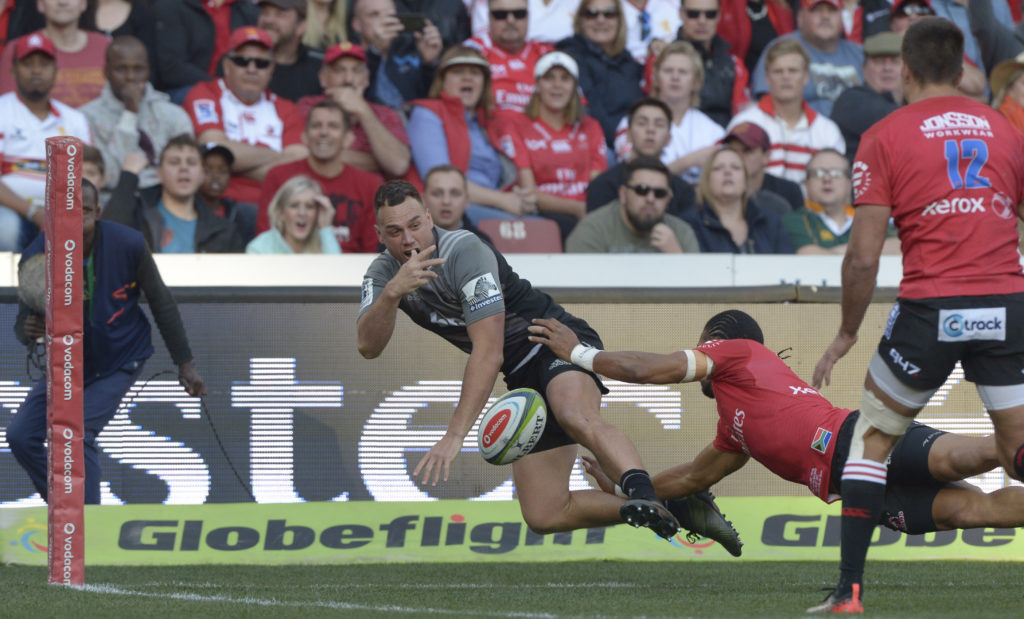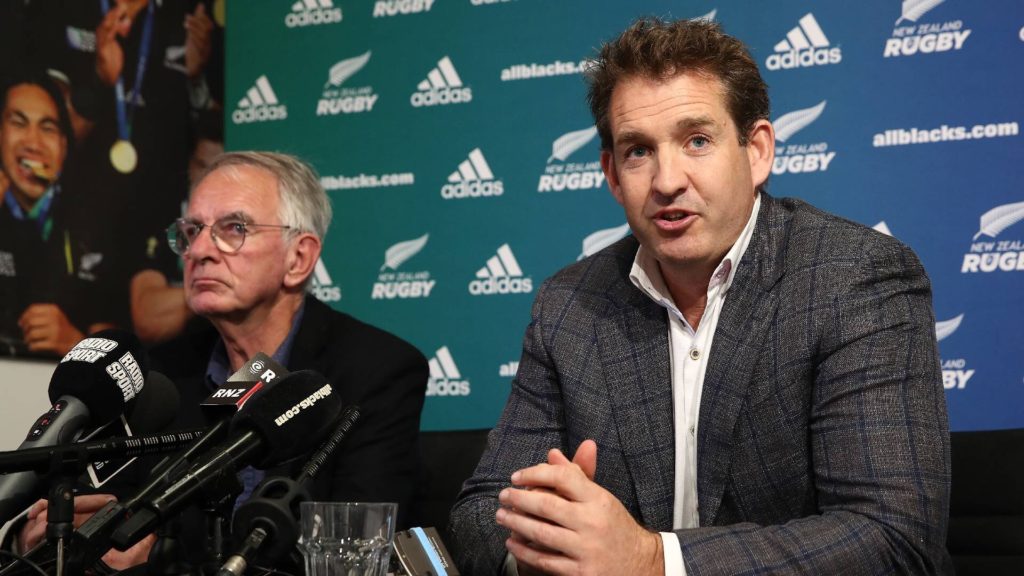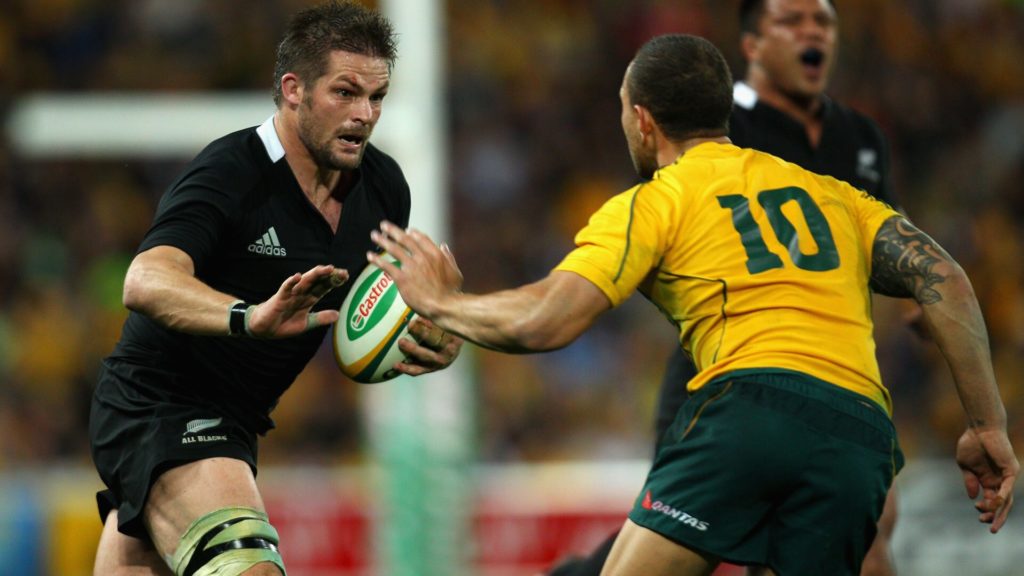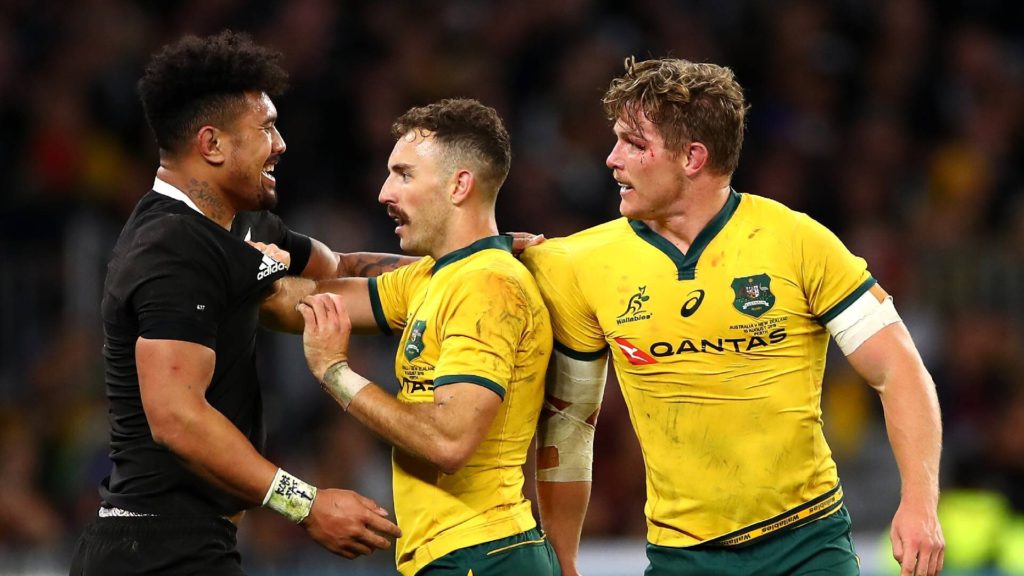Supposedly the great German general and military strategist Erwin Rommel said that if his mission was to invade Hell, he’d enlist Australian soldiers to take it and New Zealanders to hold it.
He, like many Germans, had seen the combined effectiveness, power and esprit de corps of Anzac troops fighting side by side in the second World War.
New Zealanders and Australians, were seen by the rest of the world as one united force – two colonial upstarts, joined at the hip in the trenches, willing to die for one another.
It’s all true in a military context but the Anzac relationship is neither simple nor without bickering, rancour, pettiness and bitterness in a modern rugby setting. The Bledisloe Cup has experienced more plot twists and dramatic episodes than your typical day-time soap opera and has regularly strayed beyond where fiction writers would be willing to go.
How the two nations have come to be such firm enemies yet maintain in times of emergency a genuine bond that will see them drop everything to come to the other’s aid, makes the Bledisloe Cup the most compelling rugby event on the planet.
In the last 20 years, the storylines produced have been epic but somehow the relationship has survived. The Anzac brothers have fought, squabbled and stabbed each other in the back but somehow found a way to remain united – committed to their Sanzaar alliance.
In the build-up to the 2020 series, the two nations have been locked in the midst of yet another ill-tempered tangle of political shenanigans, sneak attacks and public spats.
But this time the fighting has been so intense and bitter that Rugby Australia chairman Hamish McLennan has claimed: “I think the relationship is probably at the lowest ebb it’s ever been at.”
It has left the Sanzaar alliance hanging by a thread and the prospect of a highly explosive four-test Bledisloe series.
There’s an argument to be made that New Zealand and Australia so desperately need one another to remain viable in professional rugby, that there is nothing that could irreversibly damage their relationship.
In 1995 New Zealand, South Africa and Australia formed the Sanzar alliance to create Super Rugby and the Tri-Nations as it was then, pooling their combined resources to sell for a stunning US$555 million broadcast contract.
For 25 years they have been together, inviting Argentina to join in 2012 and Japan, through the Sunwolves, in 2016. The Southern Hemisphere giants were all convinced they were stronger together but in the last six months that theory has been shattered.

New Zealand came out of its pandemic lockdown in June this year and unilaterally declared it was blowing up Super Rugby as we knew it. They said Super Rugby as it stood was broken. The multiple time zones, the constant travel, the abundance of weak teams and the flawed format had all combined to kill interest.
When New Zealand saw crowds flock to the hurriedly created Super Rugby Aotearoa and broadcast audiences boom, the national body knew it could go it alone and that it would indeed most likely have to as travel restrictions were going to make it all but impossible to include South Africa, Argentina and Japan in the near future anyway.
And while there is a real prospect of a trans-Tasman travel bubble being signed off next year, what worried NZR was that Australia don’t have a broadcast deal in place for 2021.
New Zealand has secured a five-year broadcast deal with Sky, worth a reported $450million and the prospect of continuing to run Super Rugby through Sanzaar and evenly split income to subsidise weak Australian teams, held zero appeal.
No longer could New Zealand see they would be stronger together so they said they were out, doing their own thing in Super Rugby in 2020 and 2021 but willing to discuss how things could potentially be stitched back together in 2022 when the impact of Covid had lessened.
In the last 20 years, the storylines produced have been epic but somehow the relationship has survived. The Anzac brothers have fought, squabbled and stabbed each other in the back but somehow found a way to remain united – committed to their Sanzaar alliance.
If they thought, as they clearly did, that South Africa would muddle through this year and next and keep the door open to a cross-border champions-league-style play-off series in 2022, they were sorely mistaken.
On September 30, the South African Rugby Union voted to leave Super Rugby and inject the Sharks, Bulls, Stormers and Lions into what will become the Pro 16.
“We would not have been taking this decision but for actions elsewhere,” SARU chief executive Jurie Roux said in a statement, laying the blame for the defection at New Zealand’s door.
With South Africa out of Super Rugby, New Zealand and Australia are now staring at each other across the Tasman unsure whether they can patch things up and rebuild a trans-Tasman version of Super Rugby.
They both want to, but they greatly differ on how it should be funded, structured and governed and right now they are so busy hating each other and bickering that acrimonious divorce seems more likely than yet another reconciliation.

Australia haven’t laid out a vision as such for how they imagine a trans-Tasman Super Rugby set-up, but they have made it clear it should include all five of their current teams, an even split of revenue and joint governance.
New Zealand, however, have declared they will run a five-team Super Rugby Aotearoa again in 2021 and are now working with four new bidders to create at least three new teams to join their competition in 2022.
Australian teams were invited to tender expressions of interest to join in 2022, but none did, leading NZR chairman Brent Impey to say on October 1: “They didn’t want to be involved in our expression of interest process – that’s entirely up to them. We have the door open to them around a crossover competition once Super Rugby Aotearoa is over in 2021, and we’ve also got the door open on a trans-Tasman-type competition.”
Rugby Australia dispute the door really is open. New Zealand has self-appointed itself as the owner and governor of Super Rugby and has dictated terms of entry and inclusion.
NZR’s chief operating officer Nigel Cass sent correspondence to the various bidding parties on October 1, informing them that: “New Zealand Rugby confirms its long term preference for ‘Super Rugby’ is to have an Australasian Pacific-based competition involving eight to 12 teams and that subject to final Sanzaar agreement it is seeking agreement from each of the four short-listed parties to continue to work towards confirming a minimum of three new teams to join this competition from 2022 by December 2020.”
New Zealand has been cold and aggressive towards Australia and it’s stance has been labelled as needlessly inflammatory and counter productive.
“They didn’t want to be involved in our expression of interest process – that’s entirely up to them. We have the door open to them around a crossover competition once Super Rugby Aotearoa is over in 2021, and we’ve also got the door open on a trans-Tasman-type competition.”
NZR chairman Brent Impey
New Zealand Rugby Players Association boss, Rob Nichol, has gone as far as to call it arrogant and said the day after the 2021 and 2022 plans were released: “What we don’t want is someone trying to be the king-maker in this situation. As soon as someone feels they’re in a position to dictate, a whole lot of other people want to take them down.
“We have five teams and a commercial market that’s smaller than New South Wales. Australia comes with assets. They come with experience, and legacy. Respect that legacy and work with them. This business of an eight-team competition with three new teams, we don’t get that.”
And what’s driving Nichol and others to speak out about this deliberate alienation of Australia is the knowledge that while Super Rugby Aotearoa was a roaring success, it’s not sustainable.
A five-team competition doesn’t produce enough content for broadcasters and injuries sky-rocketed due to the intense nature of the games.

Everyone could see that infuriating Rugby Australia was not smart, because when cross border travel does re-open, probably later in 2021, New Zealand is going to need to be on good terms with its old foe to form a meaningful Super Rugby competition.
What also made annoying Australia the wrong play, was that it created a need for retribution. That came when Australia snatched the Rugby Championship hosting rights and blindsided New Zealand with two unexpected blows.
The first was that they switched the opening Rugby Championship game from Sydney to Brisbane and the second, more significantly, was that they changed the length of the tournament from five weeks to six, meaning New Zealand’s players would be in managed quarantine over Christmas.
NZR chief executive Mark Robinson took less than a minute once the news was public, to say: “We haven’t agreed to this. We were working on the understanding and all our planning and scheduling was on the basis that the All Blacks last match would be on December 5.”
What we don’t want is someone trying to be the king-maker in this situation. As soon as someone feels they’re in a position to dictate, a whole lot of other people want to take them down.
NZRPA director Rob Nichol
A resolution to that problem still hasn’t been found and New Zealand have said they are considering all options at the moment – and that includes possibly boycotting the last match or the entire tournament.
The marriage is most definitely on the rocks and no one can be sure it will survive until the end of the year, but what is certain, is that the four-test Bledisloe series is inevitably going to reflect the tension that exists.
It’s not uncommon for a Bledisloe Cup series to be played to a backdrop of boardroom chicanery. There’s been plenty of it. In 2005, Australia voted for Japan to host the 2011 World Cup and not New Zealand.
In December 2007 Crusaders coach Robbie Deans walked out of New Zealand Rugby’s headquarters in Wellington after being told he’d missed out on the All Blacks job, got in a taxi, headed to the airport and was unveiled as coach of the Wallabies in Sydney a day later.
It was a smart hire by the Australians but its intent was as much to get under New Zealand’s skin as it was to rejuvenate the Wallabies.
Still, these old foes put it behind them as they did when Deans ordered his players not to have a post-match drink with the All Blacks in Christchurch 2010.
As they did when the All Blacks felt that the Wallabies were deliberately targeting captain Richie McCaw off the ball between 2010 and 2012.

The last four years have seen tension escalate to unprecedented levels. The 2016 series was played out in the midst of a New South Wales Federal Police investigation after the All Blacks found a listening device in their hotel in Sydney before the first Bledisloe test.
That saga ended 12 months later when the All Blacks’ head of security was found not guilty of planting the device. It was an incredible episode and as it finished, internecine warfare within Australia broke out after the Sanzaar partners agreed in early 2017 that three teams had to be cut from Super Rugby.
South Africa had to axe two, Australia one because the competition was bleeding cash and the process in the latter was long, fraught and nasty with the Force threatening then taking legal action when they were the ones chopped.
The marriage is most definitely on the rocks and no one can be sure it will survive until the end of the year, but what is certain, is that the four-test Bledisloe series is inevitably going to reflect the tension that exists.
The prevailing view was that the Kiwis had pushed hard and aggressively for an Australian scalp to be taken.
Relations were damaged further last year when it leaked out that All Blacks coach Steve Hansen had called his Wallabies counterpart, Michael Cheika, Mickey Mouse at a fundraising dinner. At a question and answer session on stage, Hansen was asked what he thought of former Wallaby Mark Ella’s belief that Mickey Mouse could coach the All Blacks. “He can’t,” replied Hansen, “He’s already coaching Australia.”
What’s been undeniable is the correlation between off-field tension and intense, occasionally spiteful Bledisloe Cup encounters.
In 2016, the All Blacks were controlled fury when they met the Wallabies in Sydney – the game of course being played the same day the Police investigation into the listening device was sparked.
New Zealand crushed Australia 42-8 and when the teams met a week later in Wellington, the Wallabies, feeling they had been directly accused of planting the bug, came with a plan to infuriate the All Blacks by consistently playing them off the ball.

There were endless scuffles, half fights and verbal exchanges and despite winning 29-9, Sam Cane said a few days later: “We knew they would come out a lot more physical and potentially with a bit of niggle. The way they went about it was probably what caught us off guard just a fraction but we acknowledged it pretty quickly that that was how they were going to play.”
A year later, when the All Blacks were raging about the way the court case had played out, they were 54-7 up after 55 minutes. When the Australians were then in the midst of their civil war caused by the axing of the Force, they played the most physical game of Cheika’s reign in Brisbane, tackling the All Blacks into submission and fronting in the forwards with the sort of aggression few thought they had.
It was the most brutal Bledisloe of the last decade and then in Perth we saw the All Blacks, perhaps angry about the way the Wallabies had made a meal of the Mickey Mouse business, went after captain Michael Hooper.
At one stage, Ardie Savea shoved Hooper’s into the turf with enough venom for him to bounce and then just before half-time, Scott Barrett was sent off when his shoulder collected the Wallabies’ captain’s head.
Rod Kafer, the former Wallaby turned TV analyst, said: “You go into games trying to unsettle the leaders of an opposition team, it’s pretty standard. It didn’t surprise me to see those two illegal acts on the Wallaby captain — it may well have been part of the tactic going into the game.”

Hansen refuted that but he did say: “That’s dumb footy, we’ve got to be smarter than that. Our discipline was poor.”
The 2020 series has the additional plot-line of Dave Rennie now being head coach of the Wallabies. What makes that intriguing is that Rennie succeeded new All Blacks coach Foster at the Chiefs in 2012. Foster had been with the club since 2004 and won nothing, Rennie arrived and took them to two titles and never once missed the play-offs.
The two are respectful and cordial rather than close and Rennie is the sort of character who would love nothing more than to mastermind a Bledisloe Cup victory in New Zealand to stick two fingers up at an establishment which he feels never fully respected him.
The scene could hardly be more explosive or tense and this is what makes the Bledisloe Cup so compelling. It thrives on drama and political intrigue and is why New Zealand and Australia need each other as much as they ever have.


Comments
Join free and tell us what you really think!
Sign up for free